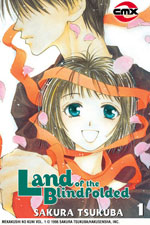 Land of the Blindfolded, vol. 1-9
Land of the Blindfolded, vol. 1-9
Story and art by Sakura Tsukuba
CMX, 2004-2006
Original Japanese editions: Hakusensha, 2000-2004
Paperback $9.99
ISBN-13: 978-1401205249 (vol. 1)
ISBN-13: 978-1401205256 (vol. 2)
ISBN-13: 978-1401205263 (vol. 3)
ISBN-13: 978-1401205270 (vol. 4)
ISBN-13: 978-1401205287 (vol. 5)
ISBN-13: 978-1401210168 (vol. 6)
ISBN-13: 978-1401210175 (vol. 7)
ISBN-13: 978-1401210182 (vol. 8)
ISBN-13: 978-1401210526 (vol. 9)
Kanade is a high school student with a special ability that she keeps very secret. When she comes in contact with another person, she sometimes sees a moment of his or her future. For the most part, such moments are something she dreads, to the point that any unexpected physical contact “sets [her] heart off like a jackhammer.” But things begin to change when she literally runs into Arou, a recent transfer to her school. Arou immediately realizes that he and Kanade have something in common, because when he comes in contact with another person, he can see that person’s past.
Though Kanade and Arou are immediately drawn to each other, they disagree on what they should do with their abilities. Arou has a strict policy of not getting involved in other people’s lives, while Kanade tries to change the future for the better when she can. And when Kanade’s actions have some unhappy results, Arou’s only more convinced that he is right.
Land of the Blindfolded is a series that succeeds partly because it is not particularly ambitious. The main characters may have extraordinary powers, but Tsukuba is telling a modest, small-scale story. This is not an epic fantasy by any stretch of the imagination. As a result, this is also a story where small things matter. Where other series get caught up in fame, fortune, and the fate of the world, Land of the Blindfolded doesn’t forget the importance of family, friendship, and everyday decisions to do the right thing.
The end result is cute, mostly because Kanade and Arou’s interactions are so adorable. In many ways, Kanade is a pretty generic shōjo heroine. She’s friendly and upbeat; she cares a lot for the people around her; she always tries to do her best. Arou’s a little less innocent, which means he often can’t understand why Kanade tries so hard. But it’s soon clear that he’s not the aloof observer that he’d like to be. Tsukuba really captures the sweetness of first love as they circle around each other. And because this is such a modest story, there are sometimes failures of communication, but never any unreasonable or melodramatic Big Misunderstandings™.
My main complaint about the series is that Kanade remains a fairly static character. The two main male characters–Arou and Namiki, who appears toward the end of volume 1–get more opportunities to angst and thus more character development. This is a common weakness of shōjo series; for example, it’s also present in the character arcs in Masami Tsuda’s Kare Kano. I still liked Kanade a lot, but she does spend a little too much of the story simply being Arou’s and Namiki’s supporter and ideal.
Tsukuba’s art isn’t spectacular, but it does a good job of conveying how every touch is meaningful for her main characters. I also especially liked her chibi figures. There’s a lot of gentle humor in this series, and the art captures that.
Don’t pick up Land of the Blindfolded if you’re looking for something groundbreaking or gamechanging–this is just not that kind of work. But if you’re in the mood for a comfort shōjo read, you could definitely do worse. The series is rated for all ages, and I suspect its particular type of sweetness would make it a particularly good choice for the tween set.
Previews of all 9 volumes are available at the CMX website.
Pingback: The importance of being edited « MangaBlog
September 11, 2010 at 9:09 pm
Land of the Blindfolded is my favorite manga. :)